Let’s work out an easier way to find those magic numbers in the last post.
Again, consider the example 6x^2+x-12
As we said last time, to factor by grouping you need to find factors of 6 * -12 that add up to 1. (1 because that is the multiplier of x in the middle term.)
These are the possibilities:
| Factors of 6 |
|
Factors of -12 |
|
1, 6
|
|
-1, 12 |
|
2, 3
|
|
12, -1 |
|
|
-2, 6
|
|
|
2, -6
|
|
|
-3, 4
|
|
|
3, -4
|
How can you combine two factors of 6 with two factors of -12 to get 1? Let’s see how we can narrow the possibilities to minimize the guesswork. We already know that the absolute values of the two magic numbers have a difference of 1. In other words, those two numbers are opposite in sign and almost the same in size.
What else can we say?
Let’s look at the prime factors we have to work with:
6 = 2*3
-12=-1*2*2*3
6*-12=-1*2*2*2*3*3
Notice that our prime factors contain lots of 2s and 3s. Yet 1, the number to which the magic numbers have to add up, contains no factor of 2 or 3. If *both* magic numbers had a factor of 2, their sum would have a factor of 2. But 1 has no factor of 2. So 2 must be in just one of the magic numbers.
Similarly for 3, if both magic numbers had a factor of 3, their sum would have a factor of 3. But 1 has no factor of 3, so 3 must be in just one of the magic numbers. Since 2s and 3s are all we’ve got, the magic numbers may be 2*2*2=8 and -3*3=-9 or -8 and 9, or -8 and 9, or -1 and 72, or 1 and -72. But we said the magic numbers must add up to a positive number, 1, so they must be -8 and 9.
Let’s try that with another example:
15x^2+8x-16
Prime factors of a, 15: 3, 5.
Prime factors of c, -16: -1, 2, 2, 2, 2
Prime factors of 15*-16: -1, 2, 2, 2, 2, 3, 5
b for this trinomial is 8, an even number whose only prime factor is 2 (repeating). The magic numbers that you add together to get 8 must be both even or both odd, because an even plus an odd — or an odd plus an even — makes an odd sum. But they can’t both be odd, because together they must contain four factors of 2 — and a factor of 2 makes a number even. So the magic numbers must both be even. For both magic numbers to be even, each one must contain at least one factor of 2.
Here is a guess as to how those 2s fall out in the magic numbers:
Could that work? Let’s take the divisibility reasoning one step farther. b, 8, is divisible by 4. A number that is divisible by 4 may be the sum of either two numbers that are divisible by 4 or two that are not. That means the factors of 2 cannot be distributed with 2 on one team and 8 on the other, because 2 is not divisible by 4 but 8 is.
What possibilities remain?
What if all four 2s are on one team? That would mean 1 on Team A and 16 on Team B. That doesn’t work, because that’s one number that’s divisible by 4 and one that is not — and we need either two that are or two that are not.
Pretty much all that leaves is one 4 on each team:
Then where do the 3 and the 5 go? Either they combine into 15 or they go onto opposite teams. Note that b is the difference between the absolute values of the magic numbers. b=8. That’s not a huge number. If 3 and 5 are both on the same team, then the difference between the absolute values of the magic numbers will be 15*4-4=56, way too large a number.
| Team A |
Team B |
| 4*15=60 |
-4*1=4 |
The only other possibility is that one team gets 3 and the other gets 5:
| Team A |
Team B |
| 4*3=12 |
-4*5=-20 |
Add those together and you get -8. We need 8. So switch the -1:
| Team A |
Team B |
| -1*2*2*3=-12 |
2*2*5=20 |
-12+20=8. That works. So the magic numbers are -12 and 20.
Continue and factor by grouping:
15x^2+8x-16
Break up the middle term using the magic numbers:
15x2-12x+20x-16
Factor the common factors out of the first pair of terms and the second pair of terms:
3x(5x-4)+4(5x-4)
Factor out 5x-4 from both pieces:
(3x+4)(5x-4). These are the factors.
Summary example:
| 20x^2-17x-63 |
|
| Prime factors of 20: 2, 2, 5
Prime factors of -63: -1, 3, 3, 7
Prime factors of 20 * -63: -1, 2, 2, 3, 3, 5, 7 |
List the prime factors of a and c. |
| 2, 2; 3, 3. |
List the repetitions |
| -17 |
Find b |
| b, -17, is not divisible by either repeated number. |
Is one of the repeated factors of ac a factor of b? |
Neither 2 nor 3 can be in both magic numbers. Guess that the 2s together and the 3s together will be on separate teams:
| Team A |
Team B |
| 2*2=4 |
3*3=9 |
|
Start setting up team A and team B |
| Team A |
Team B |
| 4*-5=-20 |
9*7=63 |
|
Consider the remaining factors and guess which teams they are on. |
| -20+63=43, not b |
Check. Do the numbers add up to b? |
| Team A |
Team B |
| 4*-7=-28 |
9*5=45 |
|
If not, check your guesses and make new ones. |
| -28+45=17. Check. |
Check. Do the numbers add up to b? |
This method removes some of the guesswork, but not all of it.
Will this method work every time? No, it depends on repetition of factors, something that does not always happen. But for the most part, the big coefficients in the really ugly problems factor either into many small prime numbers — of which some probably repeat — or into large prime numbers, leaving you with not that many combinations to consider.


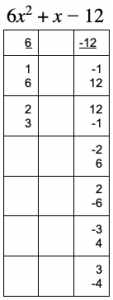
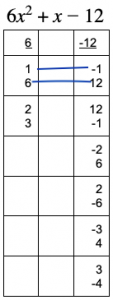 to use the other term in the same box as 1 — that’s 6 — as well as the other c term in the same box as -1. That’s 12. Then one pair of possible magic numbers we could try would be 1*-1=-1 and 6*12=72. We need those numbers to add up to b, the multiplier of x in the middle term — in this case that’s 1.
to use the other term in the same box as 1 — that’s 6 — as well as the other c term in the same box as -1. That’s 12. Then one pair of possible magic numbers we could try would be 1*-1=-1 and 6*12=72. We need those numbers to add up to b, the multiplier of x in the middle term — in this case that’s 1.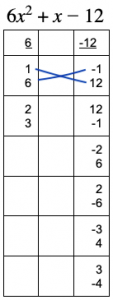 Try 1 * 12 + 6 *-1 = 6. Getting closer, but there’s still a way to go.
Try 1 * 12 + 6 *-1 = 6. Getting closer, but there’s still a way to go. 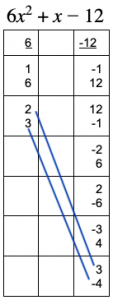 Tr
Tr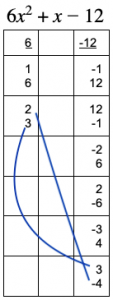 y 2, 3 for a and 3, -4 for c? 2*3+3*-4=6 – 12 = -6. Doesn’t work, so try flipping the correspondence: 2*-4 +3 * 3 = -1. Bingo. The magic numbers are 2*-4=-8 and 3*3=9.
y 2, 3 for a and 3, -4 for c? 2*3+3*-4=6 – 12 = -6. Doesn’t work, so try flipping the correspondence: 2*-4 +3 * 3 = -1. Bingo. The magic numbers are 2*-4=-8 and 3*3=9.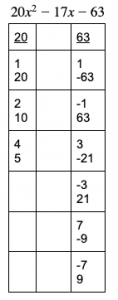
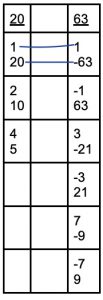
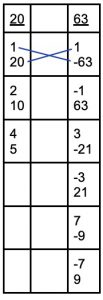 20 *1 (=-43, doesn’t work) and work our way down the column that way.
20 *1 (=-43, doesn’t work) and work our way down the column that way. 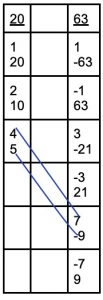 With some trial and error*, you can find that the magic factor pairs are 4*7=28 and +5*-9=-45. 28-45=-17. Bingo.
With some trial and error*, you can find that the magic factor pairs are 4*7=28 and +5*-9=-45. 28-45=-17. Bingo.

